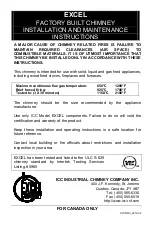
ENGLISH
22 / 36
0006160064_201510
t2', t3', t4' :
Such time intervals are valid only for burner command and control
equipment of series 01, i.e. LFL1.335, LFL1.635, LFL1.638.
They do not apply to burners of the series 02 since they have a
simultaneous activation of the X and VIII cams.
OPERATION
The drawings above show both the connection circuit and the se-
quencer mechanism control program.
A
Start-up confirmation by means of thermostat or the
installation pressure switch “R”
A-B
Start-up program
B-C
Normal burner operation (based on “LR” power regulator
control commands)
C
Stop controlled by “R”
C-D
Programmer return to start-up position A, post-ventila-
tion.
During periods of burner inactivity, only the 11 and 12
control outputs are powered and the air shutter is CLO-
SED by the "z" limit switch of the relevant servomotor.
During the probe test and the false flame test, also the
flame supervision circuit is powered (terminals 22/23 and
22/24).
SAFETY STANDARDS
• In association with the use of QRA…, grounding of terminal 22
is compulsory.
• The power cables must conform to existing national and local
standards.
• LFL1… is a safety device, and it is therefore forbidden to open
it, tamper with it or modify it!
• The LFL1… device must be completely insulated from the
mains before carrying out any operations on it!
• Check all the safety functions before activating the unit or after
replacing a fuse!
• Provide protection against electric shock on the unit and all
electric connections.
• During use and maintenance, take care to prevent any infiltra-
tion of condensation water on the controls.
• Electromagnetic emissions must be verified during use.
CONTROL PROGRAM IN CASE OF STOPPING AND INDI-
CATION OF STOP POSITION
As a rule, in the event of any kind of stop, the fuel flow is immedia-
tely cut off. At the same time both the programmer and the switch
position indicator remain in the same position. The symbol on the
indicator reading disk indicates the fault type.
No start-up
, because of failed closure of one contact,
or lock-out stop during or at the end of the control se-
quence due to external lights (for example not extingui-
shed flames, loss at the level of fuel valves, flame control
circuit faults, etc.)
Stat-up sequence interruption
, because the OPEN
signal has not been sent to terminal 8 by limit switch
contact "a". Terminals 6, 7 and 15 remain live until fault
removal!
P
Lock-out stop
, due to no air pressure signal.
From
this moment on, any missing air pressure
indication triggers a lock-out stop!
Lock-out stop
due to flame detection circuit malfun-
ction.
Start-up sequence interruption
, since the position
signal of low flame has not been sent to terminal 8 from
auxiliary switch “m”. Terminals 6, 7 and 15 remain live
until fault removal!
1
Lock-out stop
, due to lack of flame signal at the end
of the first safety time.
2
Lock-out stop
, because no flame signal was received
at the end of the second safety time (main flame signal
with pilot burners at intermittent operation).
׀
Lock-out stop
, due to no flame signal during burner
operation.
Summary of Contents for GI 700 MC
Page 2: ......
Page 34: ...ITALIANO 32 36 0006160064_201510 SCHEMI ELETTRICI ...
Page 35: ...ITALIANO 33 36 0006160064_201510 ...
Page 36: ...ITALIANO 34 36 0006160064_201510 ...
Page 38: ...ITALIANO 36 36 0006160064_201510 ...
Page 70: ...ENGLISH 32 36 0006160064_201510 WIRING DIAGRAMS ...
Page 71: ...ENGLISH 33 36 0006160064_201510 ...
Page 72: ...ENGLISH 34 36 0006160064_201510 ...
Page 74: ...ENGLISH 36 36 0006160064_201510 ...
Page 75: ......
















































